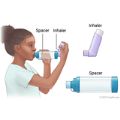Health Library
We have a vast digital library of medical information, including wellness and psychiatry topics as well as general medical topics. For more information or to schedule an appointment, don’t hesitate to call us.
Our Health Library information does not replace the advice of a doctor. Please be advised that this information is made available to assist our patients to learn more about their health. Our providers may not see and/or treat all topics found herein. Asthma is a lung condition that makes it hard for your child to breathe. It causes the airways that lead to the lungs to swell and get inflamed. Some children have breathing problems only at certain times, like during allergy season, or when they get a cold, or when they exercise. Others have breathing problems a lot of the time. When asthma symptoms suddenly get worse (or flare up), the airways tighten and get narrower. These flare-ups are also called asthma attacks or acute asthma episodes or exacerbations (say "ig-ZAS-ur-BAY-shuns"). Treatment can help your child feel and breathe better and help keep your child's lungs healthy. Many children with asthma play sports and live healthy, active lives. Experts don't know exactly what causes asthma in children. But we do know that asthma runs in families. And it's much more common in children who have allergies. When your child has asthma, they may wheeze or cough a lot. Your child may also feel tightness in the chest or feel short of breath. To find out if your child has asthma, your doctor will do a physical exam and ask about your child's symptoms and health. The doctor may also have your child do breathing tests to find out how well your child's lungs work. Asthma is treated with medicine to help your child breathe easier. Daily controller medicine is used to prevent asthma attacks. Quick-relief medicine is for times when symptoms need to be treated fast. Treatment also includes helping your child to avoid things that might trigger symptoms and to follow an asthma action plan. You can help your child manage asthma by making sure your child takes asthma medicines the right way, follows an action plan, and avoids things that make asthma worse, like smoke and pets with fur. And you can help your child avoid getting sick by making sure your child gets COVID-19 and flu vaccines. Health Tools help you make wise health decisions or take action to improve your health. Your child may be more likely to have asthma if: Other things that may put your child at risk for asthma include: Your child may be at increased risk for very bad asthma attacks if your child: Triggers, such as air pollution, pollen, pets with fur, and colds and flu, also may make asthma worse and may lead to asthma attacks. When your child has asthma, your child may: If your child has only one or two of these symptoms, it doesn't always mean that your child has asthma. The more of these symptoms your child has, the more likely it is that your child has asthma. Symptoms of asthma can be mild or severe. Your child may have symptoms every day, just now and then, or somewhere in between. Your child may have symptoms every day, just now and then, or somewhere in between. Sometimes your child's symptoms may suddenly get worse (or flare up) and cause an asthma attack. Over time, your child's breathing problems may get more severe. Or your child may have symptoms more often. Your child may have a hard time breathing only at certain times. This may be during allergy season, when your child gets a cold, or while exercising. Or your child may have breathing problems a lot of the time. The things that make your child's asthma or breathing worse are called triggers. At times, the inflammation from asthma causes your child's airways to narrow and produce mucus. This causes asthma symptoms such as shortness of breath. Even mild asthma may cause long-term changes to your child's airways and lungs. Asthma can make lung and airway infections like bronchitis and pneumonia worse. Call 911 or other emergency services immediately if your child has any of the symptoms below. Keep using your child's asthma action plan until help arrives. Call your doctor now or seek immediate medical care if: Call your doctor if: If your child has not been diagnosed with asthma but has asthma symptoms, call your doctor and make an appointment to have your child checked. Watchful waiting is a wait-and-see approach. It may be okay as long as your child follows their asthma action plan and stays within the green zone. Monitor your child's symptoms, and continue to avoid asthma triggers. To find out if your child has asthma, your doctor will do a physical exam and ask about your child's symptoms. The doctor may also have your child do breathing (lung function) tests. These tests find out how well your child's lungs work. Diagnosing asthma in babies and toddlers is often very hard. Symptoms may be the same as those of other conditions, such as infection with respiratory syncytial virus (RSV) or inflammation of the lungs (pneumonia), sinuses (sinusitis), and small airways (bronchiolitis). If you have a very young child, a test such as spirometry isn't practical. So the diagnosis is made based on your report of symptoms. In an older child, lung function tests can help the doctor diagnose asthma, see how bad it is, and check for problems. The tests include: Asthma can be hard to diagnose because the symptoms vary widely from child to child and within each child over time. And asthma-like symptoms can also be caused by other conditions, such as the flu or other viral lung infections. So your doctor may want to do other tests. Tests that may be done to find out if conditions other than asthma are causing your child's symptoms include: Other tests may be done to see if your child has health problems such as sinusitis, nasal polyps, or gastroesophageal reflux disease. Asthma is treated with medicine to help your child breathe easier, along with self-care. Other treatments, like counseling, may also be used. It's very important to treat your child's asthma, even if your child feels good most of the time. That's because mild asthma may also cause changes to the airways. Babies and small children need early treatment for asthma symptoms to prevent severe breathing problems. They may have more serious problems than adults because their bronchial tubes are smaller. By following your child's treatment plan, you can help your child meet these goals: Most medicines for asthma are inhaled. These types of medicines go straight to your child's airways, where the problem is. The main medicines used to treat asthma include: Other medicines may be given in some cases. Your child needs to have regular checkups to keep asthma under control and to ensure the right treatment. How often your child needs checkups depends on how well the asthma is controlled. Treatment also includes things you can help your child do to manage asthma, like avoiding things that might trigger symptoms and following an asthma action plan. Other treatments may be used to treat asthma. They include: There are things you can help your child do to manage asthma. Make sure that your child: Common triggers include colds, smoke, air pollution, dust, pollen, mold, pets with fur, cockroaches, stress, and cold, dry air. Here are some ways you can help your child avoid triggers: You can help your child follow their asthma action plan. This is a written plan that will help your child manage asthma every day and know what to do during an asthma attack. A plan also helps you and your child make quick decisions about medicine and treatment. If your child doesn't have an action plan, work with your doctor to make one. If your child is old enough to understand the process, teach your child what symptoms to watch for. And help your child understand how to follow their asthma action plan. You can monitor your child's symptoms by watching for changes in how much your child is coughing, wheezing, or short of breath. If your child is old enough to understand what to do, you can monitor your child's symptoms by checking their peak expiratory flow (if your doctor recommends that you do this). Measuring peak flow is a way to keep track of asthma symptoms at home. It can help you and your child know when lung function is getting worse before it drops to a dangerously low level. This is done with a peak flow meter. It's easy to underestimate how bad your child's symptoms are. You may not notice them until your child's lungs are functioning at 50% of the personal best peak expiratory flow. Medicine helps your child breathe easier and control their asthma. It doesn't cure asthma. But it's an important part of managing asthma in your child. Medicines for asthma treatment are used to: Most medicines for asthma are inhaled. They allow a certain dose to be given directly to the airways. Most doctors recommend that every child who uses a metered-dose inhaler (MDI) also use a spacer. The spacer is attached to the MDI. A mask spacer has a face mask that fits over your child's mouth and nose. Young children who have trouble using their inhalers can use a mask spacer. A spacer may deliver the medicine to your child's lungs better than an inhaler alone. And for many people, a spacer is easier to use than an MDI alone. Using a spacer with inhaled steroid (corticosteroid) medicines can help reduce their side effects and the need for oral medicine. Try to avoid giving your child an inhaled medicine when your child is crying. When a child cries, not as much medicine is delivered to the lungs. The main medicines used to treat asthma include: Your doctor may recommend other medicines if your child has severe allergic asthma and the symptoms aren't relieved by avoiding allergens or by taking standard medicines. Medicine treatment for asthma depends on your child's age and type of asthma. It also depends on how well the treatment is helping asthma symptoms. The goal is to use the least amount of medicine to control asthma symptoms. Current as of: September 29, 2025 Author: Ignite Healthwise, LLC Staff Current as of: September 29, 2025 Author: Ignite Healthwise, LLC Staff Clinical Review Board This information does not replace the advice of a doctor. Ignite Healthwise, LLC disclaims any warranty or liability for your use of this information. Your use of this information means that you agree to the Terms of Use and Privacy Policy. Learn how we develop our content. To learn more about Ignite Healthwise, LLC, visit webmdignite.com. © 2024-2025 Ignite Healthwise, LLC.Asthma in Children
Condition Basics
What is asthma?
What causes it?
What are the symptoms?
How is it diagnosed?
How is asthma treated?
How can you help your child manage asthma?
Health Tools
What Increases Your Risk
Other risk factors
Risks for very bad asthma attacks
Symptoms
Learn more
What Happens
Learn more
Watch
When to Call a Doctor
If you think your child has asthma
Watchful waiting
Exams and Tests
Breathing (lung function) tests
Tests for other conditions
Learn more
Watch
Treatment Overview
Medicines
Self-care
Other treatments
Learn more
Caring for Your Child
Taking medicines
Avoiding triggers
Following an asthma action plan
Monitoring symptoms
Learn more
Watch
Medicines
Medicine choices
How your doctor prescribes asthma medicines
Learn more
Watch
Related Information
Credits
Clinical Review Board
All Ignite Healthwise, LLC education is reviewed by a team that includes physicians, nurses, advanced practitioners, registered dieticians, and other healthcare professionals.
All Ignite Healthwise, LLC education is reviewed by a team that includes physicians, nurses, advanced practitioners, registered dieticians, and other healthcare professionals.




